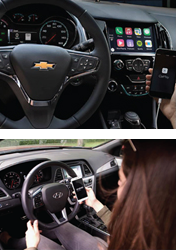|
Apple (Cupertino,
California) and Google’s Android (Mountain View, California) together sell 95%
of the smartphones in the United States, but, for years, they have been largely
locked out of the automobile industry. Now, nearly every major automaker is preparing
to share a ride with these smartphones. Apple’s CarPlay smartphone and its
Google counterpart, Android Auto, are bringing their familiar smartphone
screens and functionality, complete with all the intelligence and voice  control
technology, right to the car’s dashboard. control
technology, right to the car’s dashboard.
It is a revolution not only for drivers but
also for automakers, which are threatened with the loss of their traditional
control on expensive and often optional navigation and infotainment systems.
The market has spoken: “Consumers expect their favorite smartphone environment and
connected lives—smartphone contacts, music, social media, and apps—to follow
them wherever they go. With Apple and Android being the dominant intuitive
platforms people use every day, they’re not going to want to be closed off from
them in the car,” said Steve Cannon, chief executive of Mercedes-Benz USA.
Cannon added, “That’s especially true for
millennials, the age 18–34 demographic that will soon surpass the baby boomers
as America’s largest living generation. If you’re not keeping pace with
connected cars and autonomous functions, you’re not going to connect with these
younger buyers.” Mercedes will begin rolling out Apple CarPlay connectivity on
its 2016 models.
Read the full article: "Advances in Automotive Electronics", IEEE Vehicular Technology Magazine, Volume 10, Issue 4, December 2015. |